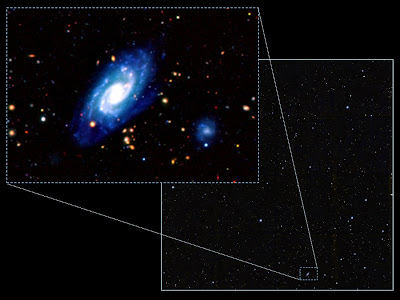 Zooming into a small fraction of the UKIDSS UDS field, the deepest infrared image ever obtained over such a large area. The zoom shows a relatively nearby spiral galaxy. Many of the faint red objects in the background are massive galaxies at distances of over 10 billion light-years. Credit:JAC/UKIRT
Zooming into a small fraction of the UKIDSS UDS field, the deepest infrared image ever obtained over such a large area. The zoom shows a relatively nearby spiral galaxy. Many of the faint red objects in the background are massive galaxies at distances of over 10 billion light-years. Credit:JAC/UKIRTAstronomers have produced an image containing more than 100,000 galaxies.
Provided by the Joint Astronomy Centre
UK astronomers have produced the most sensitive infrared map of the distant universe ever undertaken. Combining data over a period of 3 years, they have produced an image containing over 100,000 galaxies over an area four times the size of the full Moon. Some of the first results from this project will be presented by Sebastien Foucaud from the University of Nottingham today at the RAS National Astronomy Meeting in Belfast.
Due to the finite speed of light, these observations allow astronomers to look back in time over 10 billion years, producing images of galaxies in the universe's infancy. The image is so large and so deep that thousands of galaxies can be studied at these early epochs for the first time. By observing in the infrared, astronomers can now peer further back in time, since light from the most distant galaxies is shifted towards redder wavelengths as it travels through the expanding universe.
"I would compare these observations to the ice cores drilled deep into the Antarctic," says Foucaud. "Just as they allow us to peer back in time, our ultra-deep image allows us to look back and observe galaxies evolving at different stages in cosmic history, all the way back to just 1 billion years after the Big Bang".
One of the key aims is to understand when the rarest, most massive galaxies form in the distant universe, which is a long-standing unsolved problem in astronomy. "We see galaxies 10 times the mass of the Milky Way already in place at very early epochs. Now, for the first time, we are sampling a large enough volume of the distant universe to be able to see them in sufficient numbers and really pin down when they were formed."
The image was obtained using the United Kingdom Infrared Telescope (UKIRT) in Hawaii. The results presented today form part of the Ultra-Deep Survey (UDS), led by Omar Almaini at the University of Nottingham. The UDS is one element of a five-part project, the UKIRT Infrared Deep Sky Survey, which commenced in 2005. Professor Andy Lawrence, Principal Investigator of UKIDSS from the University of Edinburgh, says "As we keep taking images over the next few years, we will see ever more distant galaxies."
Due to the finite speed of light, these observations allow astronomers to look back in time over 10 billion years, producing images of galaxies in the universe's infancy. The image is so large and so deep that thousands of galaxies can be studied at these early epochs for the first time. By observing in the infrared, astronomers can now peer further back in time, since light from the most distant galaxies is shifted towards redder wavelengths as it travels through the expanding universe.
"I would compare these observations to the ice cores drilled deep into the Antarctic," says Foucaud. "Just as they allow us to peer back in time, our ultra-deep image allows us to look back and observe galaxies evolving at different stages in cosmic history, all the way back to just 1 billion years after the Big Bang".
One of the key aims is to understand when the rarest, most massive galaxies form in the distant universe, which is a long-standing unsolved problem in astronomy. "We see galaxies 10 times the mass of the Milky Way already in place at very early epochs. Now, for the first time, we are sampling a large enough volume of the distant universe to be able to see them in sufficient numbers and really pin down when they were formed."
The image was obtained using the United Kingdom Infrared Telescope (UKIRT) in Hawaii. The results presented today form part of the Ultra-Deep Survey (UDS), led by Omar Almaini at the University of Nottingham. The UDS is one element of a five-part project, the UKIRT Infrared Deep Sky Survey, which commenced in 2005. Professor Andy Lawrence, Principal Investigator of UKIDSS from the University of Edinburgh, says "As we keep taking images over the next few years, we will see ever more distant galaxies."